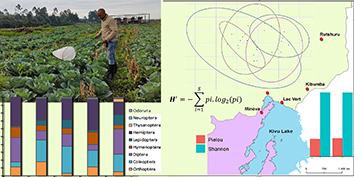Monitoring entomofauna associated with cabbage, Brassica oleracea L. var capitata in eastern DRCongo
1- Functional and Evolutionary Entomology, Gembloux Agro-Bio Tech, University of Liège, Passage des Déportés 2, 5030 Gembloux, Belgium [1]; Regional Post-Graduate Training School on Integrated Management of Tropical Forests and Lands (ERAIFT), University of Kinshasa. PoBox 15373 Kinshasa, DRCongo [2]; Department of Crop Sciences, Faculty of Agricultural Sciences and Environment, University of Goma, PoBox 204 Goma, DRCongo [3] , patientgakuru@gmail.com
2- Functional and Evolutionary Entomology, Gembloux Agro-Bio Tech, University of Liège, Passage des Déportés 2, 5030 Gembloux, Belgium
3- Department of Crop Sciences, Faculty of Agricultural Sciences and Environment, University of Goma, PoBox 204 Goma, DRCongo
2- Functional and Evolutionary Entomology, Gembloux Agro-Bio Tech, University of Liège, Passage des Déportés 2, 5030 Gembloux, Belgium
3- Department of Crop Sciences, Faculty of Agricultural Sciences and Environment, University of Goma, PoBox 204 Goma, DRCongo
Abstract: (100 Views)
Cabbage is an important component of agriculture in the eastern Democratic Republic of Congo (DRC) for its various food uses. It is important to identify pests that affect its production, which is still insufficient to meet the increasing consumer needs. Furthermore, insect data for tropical agroecosystems, particularly those of DRC are limited, making insect diversity poorly understood. The objective of this study is to assess the diversity and abundance of entomofauna related to cabbage in five different cabbage growing sites: Minova, Sake, Kibumba, Rutshuru and Lac Vert. This was achieved by trapping insects with the sweep net and yellow pantraps during 2021 and 2022. A total of 1109 insects from 9 orders and 48 families were collected. The most abundant pest families were Ciccadellidae (8%), Coreidae (7%), Chysomelidae (5%) and Pentatomidae (4%). The main families of beneficial insects (natural enemies and pollinators) identified were Syrphidae (7%), Carabidae (4%), Coccinellidae (3%) and Apidae (3%). Insect communities found in different locations were similar and diversified. Considering functions played by these different functional groups as ecological indicators, it is important to preserve entomological biodiversity. This is achieved through the rational selection of pest management methods to optimize ecosystem services provided by beneficial insects.
References
1. Arvanikatis, L. (2013) Interaction Entre la Teigne du Chou Plutella xylostella L. et ses Principaux Parasitoïdes en Conditions Tropicales: Approche éthologique, écologique et évolutive. Thèse de doctorat, Université Paul-Valéry-Montpellier 3, France. 204 p.
2. Banks, C.J. (1954) A method for estimating populations and counting large numbers of Aphis fabae Scop. Bulletin of Entomological Research, 45 (4), 751-756. [DOI:10.1017/S0007485300033368]
3. Bayendi, S.M., Poligui, R.N., Ndoutoume, A., Verheggen, F. & Francis, F. (2018) Abundance and diversity (taxon family) of entomofauna within vegetable crops of urban gardens in Libreville and Owendo (Gabon). Entomologie Faunistique, 71, 1-10.
4. Bellamy, A.S., Svensson, O., van den Brink, P.J., Gunnarsson, J. & Tedengren, M. (2018) Insect community composition and functional roles along a tropical agricultural production gradient. Environmental Science and Pollution Research, 25 (14), 13426-13438. [DOI:10.1007/s11356-018-1818-4]
5. Buckland, S.T., Magurran, A.E., Green, R.E. & Fewster, R.M. (2005) Monitoring Change in Biodiversity through Composite Indices. Philosophical Transactions of the Royal Society, 360, 243-254. [DOI:10.1098/rstb.2004.1589]
6. Byamungu, N., Rubabura, J.A.K. & Bisimwa, E.B. (2019) Impact of cabbages aphids (Brevicoryne brassicae) growing growth of cabbages, western coast of Kivu Lake. East African Scholars Journal of Agriculture and Life Science, 4472 (10), 484-489.
7. Cai, H., You, M. & Lin, C. (2010) Effects of intercropping systems on community composition and diversity of predatory arthropods in vegetable fields. Acta Ecologica Sinica, 30 (4), 190-195. [DOI:10.1016/j.chnaes.2010.06.001]
8. Campbell, J.W. & Hanula, J.L. (2007) Efficiency of Malaise traps and colored pan traps for collecting flower visiting insects from three forested ecosystems. Journal of Insect Conservation, 11 (4), 399-408. [DOI:10.1007/s10841-006-9055-4]
9. Capinera, J. (2020) Handbook of Vegetable Pests. Academic press. London, UK. 799 p.
10. Chagnon, M., Paré, D. & Brais, S. (2001) La biodiversité des collemboles et les débris ligneux après-coupe. Le Naturiste Canadien, 125 (3), 122-125.
11. Chahouki, M.A.Z. (2011) Multivariate Analysis Techniques in Environmental Science. In: Dar, I.A. (ed.) Earth and Environmental Sciences. InTech Europe, pp. 539-564. [DOI:10.5772/26516]
12. Chmelíková, L. & Wolfrum, S. (2019) Mitigating the biodiversity footprint of energy crops - A case study on arthropod diversity. Biomass and Bioenergy, 125, 180-187. [DOI:10.1016/j.biombioe.2019.04.023]
13. Colley, M.R. & Luna, J.M. (2000) Relative attractiveness of potential beneficial insectary plants to aphidophagous hoverflies (Diptera: Syrphidae). Environmental Entomology, 29 (5), 1054-1059. [DOI:10.1603/0046-225X-29.5.1054]
14. Delvare, G. & Aberlenc, H.-P. (1989) Les Insectes d'Afrique et d'Amérique Tropicale : clé pour la reconnaissance des familles. CIRAD-GERDAT, Montpellier, France. 302 p
15. Deprince, A. (2003) La faune du sol. Diversité, méthodes d'étude, fonctions et perspectives. Courrier de l'Environnement de l'INRA, 49, 123-138.
16. Desneux, N., Decourtye, A. & Delpuech, J.M. (2007) The sublethal effects of pesticides on beneficial arthropods. Annual Review of Entomology, 52, 81-106. [DOI:10.1146/annurev.ento.52.110405.091440]
17. Dunn, L., Lequerica, M., Reid, C.R. & Latty, T. (2020) Dual ecosystem services of syrphid flies (Diptera: Syrphidae): pollinators and biological control agents. Pest Management Science, 76 (6), 1973-1979. [DOI:10.1002/ps.5807]
18. Dyola, U., Baniya, C.B., Acharya, P.R., Subedi, P., Pandey, A. & Sapkota, K. (2022) Community structure of pollinating insects and its driving factors in different habitats of Shivapuri-Nagarjun National Park, Nepal. Ecology and Evolution, 12 (3), 1-14. [DOI:10.1002/ece3.8653]
19. FAO (2020) FAOSTAT online database. Food and agriculture data. https://www.fao.org/faostat/fr/#data/QCL [Accessed 01 November 2022]
20. Fening, K.O., Adama, I. & Tegbe, R.E. (2014) On-farm evaluation of homemade pepper extract in the management of pests of cabbage, Brassica oleraceae L., and French beans, Phaseolus vulgaris L., in two agro-ecological zones in Ghana. African Entomology, 22 (3), 552-560. [DOI:10.4001/003.022.0306]
21. Fidelis, E.G., das Graças do Carmo, D., Santos, A.A., de Sá Farias, E., da Silva, R.S. & Picanço, M.C. (2018) Coccinellidae, Syrphidae and Aphidoletes are key mortality factors for Myzus persicae in tropical regions: A case study on cabbage crops. Crop Protection, 112, 288-294. [DOI:10.1016/j.cropro.2018.06.015]
22. Gallai, N., Salles, J.M., Settele, J. & Vaissière, B.E. (2009) Economic valuation of the vulnerability of world agriculture confronted with pollinator decline. Ecological Economics, 68 (3), 810-821. [DOI:10.1016/j.ecolecon.2008.06.014]
23. Ghani, A. & Maalik, S. (2020) Assessment of diversity and relative abundance of insect fauna associated with Triticum aestivum from district Sialkot, Pakistan. Journal of King Saud University - Science, 32 (1), 986-995. [DOI:10.1016/j.jksus.2019.09.002]
24. Harrison, R.D., Thierfelder, C., Baudron, F., Chinwada, P., Midega, C., Schaffner, U. & van den Berg, J. (2019) Agro-ecological options for fall armyworm (Spodoptera frugiperda JE Smith) management: Providing low-cost, smallholder friendly solutions to an invasive pest. Journal of Environmental Management, 243, 318-330. [DOI:10.1016/j.jenvman.2019.05.011]
25. Herrera, R.A., Cotes, B., Agustí, N., Tasin, M. & Porcel, M. (2022) Using flower strips to promote green lacewings to control cabbage insect pests. Journal of Pest Science, 95, 669-683. [DOI:10.1007/s10340-021-01419-7]
26. Kumar, V., Kumar, R., Singh, J. & Kumar, P. (eds) (2019) Contaminants in Agriculture and Environment: Health Risks and Remediation, vol. 1. Agro Environ Media, Publication Cell of AESA, Agriculture and Environmental Science Academy, Uttarakhand, India. 283 p. [DOI:10.26832/AESA-2019-CAE]
27. Kundoo, A.A. & Khan, A.A. (2017) Coccinellids as biological control agents of soft bodied insects: A review. Journal of Entomology and Zoology Studies, 5 (5), 1362-1373.
28. Labou, B., Brévault, T., Sylla, S., DIatte, M., Bordat, D. & DIarra, K. (2017) Spatial and temporal incidence of insect pests in farmers' cabbage fields in Senegal. International Journal of Tropical Insect Science, 37 (4), 225-233. [DOI:10.1017/S1742758417000200]
29. Legendre, P. & Gallagher, E.D. (2001) Ecologically meaningful transformations for ordination of species data. Oecologia, 129 (2), 271-280. [DOI:10.1007/s004420100716]
30. Lopes, T., Bosquée, E., Lozanao, D.P., Chen, J.L., DengFa, C., Yong, L., Fang-Qiang, Z., Haubruge, E., Bragard, C. & Francis, F. (2012) Evaluation de la diversité des pucerons et de leurs ennemis naturels en cultures maraîchères dans l'est de la Chine. Entomologie Faunistique, 64 (3), 63-71.
31. Losey, J.E. & Vaughan, M. (2006) The economic value of ecological services provided by insects. BioScience, 56 (4), 311-323. [DOI:10.1641/0006-3568(2006)56[311:TEVOES]2.0.CO;2]
32. Lozano, D.P., Bosquée, E., Lopes, T., Chen, J.L., Cheng, D.F., Liu, Y., Zheng, F.Q., Haubruge, E., Bragard, C. & Francis, F. (2013) Evaluation de la diversité de l'entomofaune en cultures maraîchères dans l'est de la Chine. Entomologie Faunistique, 66, 27-37.
33. Macharia, I., Löhr, B. & De Groote, H. (2005) Assessing the potential impact of biological control of Plutella xylostella (diamondback moth) in cabbage production in Kenya. Crop Protection, 24 (11), 981-989. [DOI:10.1016/j.cropro.2005.02.005]
34. Mignon, J., Colignon, P., Haubruge, É. & Francis, F. (2003) Effet des bordures de champs sur les populations de chrysopes [Neuroptera: Chrysopidae] en cultures maraîchères. Phytoprotection, 84 (2), 121-128. [DOI:10.7202/007815ar]
35. Mignon, J., Haubruge, E. & Francis, F. (2016) Clé d'Identification des Principales Familles d'Insectes d'Europe. Les presses Agronomiques de Gembloux, Gembloux, Belgium. 87 p.
36. Mondedji, A., Nyamador, W., Amevoin, K., Ketoh, G. & Glitho, I. (2014) Efficacité d'extraits de feuilles de neem Azadirachta indica (Sapindale) sur Plutella xylostella (Lepidoptera: Plutellidae), Hellula undalis (Lepidoptera: Pyralidae) et Lipaphis erysimi (Hemiptera: Aphididae) du chou Brassica oleracea (Brassicaceae) da. International Journal of Biological and Chemical Sciences, 8 (5), 2286-2295. [DOI:10.4314/ijbcs.v8i5.30]
37. Mpumi, N., Machunda, R.S., Mtei, K.M. & Ndakidemi, P.A. (2020) Selected insect pests of economic importance to Brassica oleracea, their control strategies and the potential threat to environmental pollution in Africa. Sustainability, 12, 3824. [DOI:10.3390/su12093824]
38. Nalam, V., Louis, J. & Shah, J. (2019) Plant defense against aphids, the pest extraordinaire. Plant Science, 279, 96-107. [DOI:10.1016/j.plantsci.2018.04.027]
39. Ngom, S., Diome, T., Diop, B. & Sembene, M. (2020) Effet des extraits aqueux de Calotropis procera sur les principaux ravageurs du chou en culture au Sénégal. International Journal of Biological and Chemical Sciences, 14 (5), 1600-1610. [DOI:10.4314/ijbcs.v14i5.9]
40. Ngongo, M.L., van Ranst, E., Baert, G., Kasongo, E.L. Verdoodt, A., Mujinya, B.B. & Mukalay, J.M. (2009) Guide des sols en RD Congo, Tome I: Étude et Gestion. UGent-HoGent-UNILU, Ecole Technique Salama-Don Bosco, Lubumbashi, RD Congo. 260 p.
41. O'Connor, R.S., Kunin, W.E., Garratt, M.P.D., Potts, S.G., Roy, H.E., Andrews, C., Jones, C.M., Peyton, J.M., Savage, J., Harvey, M.C., Morris, R.K.A., Roberts, S.P.M., Wright, I., Vanbergen, A.J. & Carvell, C. (2019) Monitoring insect pollinators and flower visitation: The effectiveness and feasibility of different survey methods. Methods in Ecology and Evolution, 10 (12), 2129-2140. [DOI:10.1111/2041-210X.13292]
42. Oksanen, J., Blanchet, F.G., Kindt, R., Legendre, P., Minchin, P.R., O'Hara, R.B., Simpson, G.L., Solymos, P., Stevens, M.H.H. & Wagner, H. (2015) Vegan: community ecology package. R package vegan, vers. 2.2-1.
43. Paliy, O. & Shankar, V. (2016) Application of multivariate statistical techniques in microbial ecology. Molecular Ecology, 25 (5), 1032-1057. [DOI:10.1111/mec.13536]
44. Prabaningrum, L. & Moekasan, T.K. (2020) Incidence and diversity of insect pests and their natural enemies in control threshold-based cabbage cultivation. AAB Bioflux, 12 (1), 12-21.
45. Sarwar, M. (2020) Chapter 27 - Insects as transport devices of plant viruses. In: Awasthi, L.P. (ed) Applied Plant Virology. Academic Press, London, UK, pp. 381-402. [DOI:10.1016/B978-0-12-818654-1.00027-X]
46. Tendeng, E., Labou, B., Djiba, S. & Diarra, K. (2017) Actualisation de l'entomofaune des cultures maraîchères en Basse Casamance (Sénégal). International Journal of Biological and Chemical Sciences, 11 (3), 1021-1028. [DOI:10.4314/ijbcs.v11i3.7]
47. Tsaboula, A., Papadakis, E.N., Vryzas, Z., Kotopoulou, A., Kintzikoglou, K. & Papadopoulou-Mourkidou, E. (2016) Environmental and human risk hierarchy of pesticides: A prioritization method, based on monitoring, hazard assessment and environmental fate. Environment International, 91, 78-93. [DOI:10.1016/j.envint.2016.02.008]
48. Vayssières, J.F., Delvare, G., Maldès, J.M. & Auerlenc, H.P. (2001) Inventaire preliminaire des arthropodes ravageurs et auxiliaires des cultures maraicheres sur l'ile de la ré:union:. International Journal of Tropical Insect Science, 21 (1), 1-22. [DOI:10.1017/S1742758400020002]
49. Wagner, D.L. (2013) Moths. In: Levin, S.A. (ed.) Encyclopedia of Biodiversity, 2nd Edition. Elsevier Science, Amsterdam, The Netherlands, pp. 384-403. [DOI:10.1016/B978-0-12-384719-5.00171-4]
50. Wilkinson, L. (2011) ggplot2: Elegant graphics for data analysis by WICKHAM, H. Biometrics, 67 (2), 678-679. [DOI:10.1111/j.1541-0420.2011.01616.x]
51. Yarou, B.B., Bokonon-Ganta, H.A., Assogba-Komlan, F., Mensah, C.A., Verheggen, J.F. & Francis, F. (2018) Inventaire de l'entomofaune associée au basilic tropical (Ocimum gratissimum L., Lamiaceae) dans le Sud Bénin. Entomologie Faunistique, 71 (1), 1-10.
Send email to the article author
| Rights and permissions | |
 |
This work is licensed under a Creative Commons Attribution-NonCommercial 4.0 International License. |









